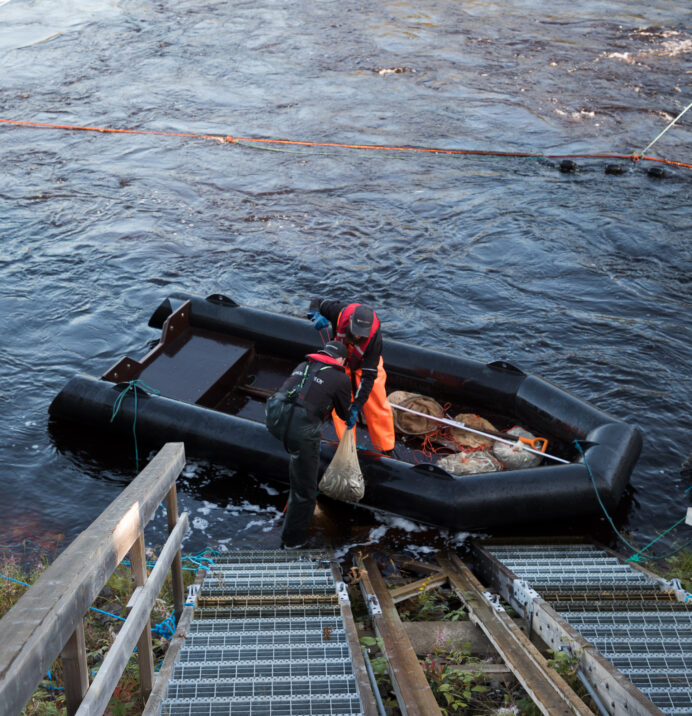
The transport of lamperns, also known as river lampreys, in the rivers Iijoki and Kemijoki concluded in October. Every year in both rivers, migrating lamperns are caught downstream from power plants and moved upstream of the plants into the river’s main channel and side streams. This year’s small lampern populations were insufficient to reach annual targets. Both weather and natural conditions contributed to the situation, but further research into lamperns is required.
For Iijoki, PVO-Vesivoima has an annual transport quota of 60,000 lamperns, just over half of which could be fulfilled this year. The differences in annual figures are monitored over a longer period in the form of a balance. This year, the quota’s overall balance fell into the negative by some 20,000 lamperns. The balance has been positive in previous years. For Kemijoki, PVO-Vesivoima and Kemijoki Oy have a larger mutual annual quota of 100,000 lamperns, and only 20,000 could be transported. The balance of Kemijoki has already been negative in previous years due to diminished lampern populations.
Annual lampern populations also dwindle in unbuilt rivers
“Transport isn’t a total replacement of the river as an undisturbed habitat for lamperns, but their annual populations were clearly smaller in the unbuilt rivers as well. It’s therefore difficult to say that any single factor could explain the situation. As lamperns haven’t been researched much, further studies are important to increase our understanding and develop our operating methods,” says Jyrki Salo, environmental expert at PVO-Vesivoima.
“Each year is quite different and affected by the weather of the fishing season, such as wind direction. A major factor this year was the exceptionally strong discharges at the mouth of the Iijoki river, which made catching difficult. It also made the lamperns head for the old channel instead of the main channel. Lamperns are less loyal to their birth river than many other migratory fish. This poses extra challenges for monitoring and research,” says Salo.
Further lampern research required
PVO-Vesivoima has been in contact with Natural Resources Institute Finland (Luke) and other parties about investing in lampern research. The need for research data has been discussed with key stakeholders, as it would not be productive to repeat the same research in all areas. Cooperation has included local holding groups, Perämeren Kalatalousyhteisöjen Liitto ry, and Voimalohi Oy.
The holding groups and lampern fishers of Iijoki’s estuary have expressed their concerns about the downward trend of their annual catch and the future of lamperns. In the municipality of Ii, an investigation of the significance and effectiveness of transport has long been demanded.
“We need clearer scientific data about where broodfish should be moved, how many larvae are born, and how successfully they migrate out to sea. The larvae are especially difficult to study, but more interest has now been expressed in researching the lamperns. We organised a lampern workshop day in June for experts to discuss the topic. Additionally, the Kalasydän fishway of the Raasakka power plant in the Iijoki river will play a greater role for lamperns in future, as they have found their way to it, and we will be testing the fishway more extensively for transport catching next year,” says Salo.
Additional information: Jyrki Salo, environmental expert, PVO-Vesivoima Oy, jyrki.salo@pvo.fi, tel. +358 50 305 8299
Pohjolan Voima’s subsidiary PVO-Vesivoima Oy produces electricity with its hydropower plants along the Iijoki, Kemijoki, and Kokemäenjoki rivers. On average, the company produces 1.7 TWh of electricity annually. The company’s dams include two fishways, one at Isohaara in Kemijoki and one at Kostonjärvi in the headwaters of Iijoki. The lowermost power plant on the river Iijoki has a Kalasydän fishway that boosts upstream migration, and the uppermost power plant in Haapakoski has Finland’s first downstream migration route for migratory fish. X, formerly Twitter: @PVOVesivoima. www.pohjolanvoima.fi